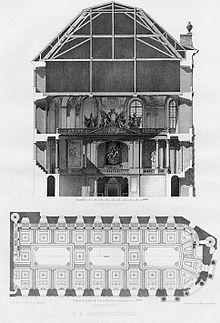George Niemann
George Niemann , also Georg Niemann , (born July 12, 1841 in Hanover , † February 19, 1912 in Vienna ) was a German-Austrian architect , building researcher , archaeologist , graphic artist and university professor . He is considered to be one of the key figures in the first significant phase of Austrian archeology.
George Niemann, brother of the writer August Wilhelm Otto Niemann , studied at the Hanover Polytechnic . Afterwards he became a student in Vienna and later also an employee of Theophil von Hansen , in 1870 finally a member of the Künstlerhaus . In 1873 he became professor for perspective and architectural style at the Vienna Art Academy . From 1903 to 1905 he was rector there .
Niemann gained his special importance as a building researcher during Austria's first major ventures in the Mediterranean region . In 1873 and 1875 he accompanied Alexander Conze on his expeditions to Samothraki , in which Otto Benndorf and Alois Hauser also took part. Study trips then took him to Olympia and London with Benndorf . In 1881 and 1882 further expeditions followed, now under Benndorf, to Asia Minor , especially to Caria and Lycia . In 1884 and 1885 further expeditions to Pisidia and Pamphylia , led by Karl Lanckoroński , followed , in which Eugen Petersen participated as an archaeologist. In 1889/1890 he accompanied Benndorf again, now to Romania . In the Tropaeum Traiani near Adamklissi he carried out building surveys together with Grigore Tocilescu , also in 1892 at the instigation of Lanckoroński at the cathedral of Aquileia . Since 1893 he has been a permanent member of the great Austrian Ephesus excavation. In 1904 he was also commissioned by Wilhelm von Hartel to start building the Diocletian's Palace in Split . As late as 1910 he was appointed Theodor Wiegand to in Didyma the Apollon edit Temple. The last work before his death in 1912 was on the Nereid Monument in Xanthos , which he was able to finish.
Niemann gained not only notoriety as an architect and building researcher, but also as a draftsman and etcher well beyond the classical studies . He was able to combine the scientifically precise drawing work of the building photographs with artistic skills. In many perspective views and reconstructions of the floor plans and elevations, he managed to bring antiquity to life. His drawings of the Heroon of Trysa were particularly valuable . For this building he also designed a building that was to house it as an architecture museum similar to the later Pergamon Museum in Berlin . However, it was not carried out. In 1941, Camillo Praschniker organized an exhibition in the Künstlerhaus Wien showing original drawings by Niemann from various archives - Spalato, Parthenon , Didyma, Erechtheion and Ephesus.
Fonts (selection)
- Handbook of linear perspective for visual artists . Stuttgart 1882. (2nd edition 1902)
-
Diocletian's Palace in Spalato. Recorded and described by George Niemann on behalf of the KK Ministry of Culture and Education . Hölder, Vienna 1910.
- New edition: Dioklecijanova palača u Splitu . Književni Krug, Split 2005, ISBN 953-163-260-X . (= Knjiga mediterana , Volume 39.)
- The Nereid Monument in Xanthos . Hölzel, Vienna 1921.
- Karl Lanckoroński (editor), with the assistance of Eugen Petersen and George Niemann: Cities of Pamphylia and Pisidia . 2 volumes, Tempsky-Freytag, Vienna / Prague / Leipzig 1890 and 1892. ( reprint : Codex, Gundholzen 1975.)
literature
- Jürgen Borchhardt : Georg (e) Niemann 1841–1912. In: Reinhard Lullies , Wolfgang Schiering (Hrsg.): Archäologenbildnisse . Portraits and short biographies of classical archaeologists in the German language. Philipp von Zabern, Mainz 1988, ISBN 3-8053-0971-6 , p. 80.
- R. Schachel: Niemann, Georg (e). In: Austrian Biographical Lexicon 1815–1950 (ÖBL). Volume 7, Verlag der Österreichischen Akademie der Wissenschaften, Vienna 1978, ISBN 3-7001-0187-2 , p. 121.
Web links
- Literature by and about George Niemann in the catalog of the German National Library
- Estates in Austria - Personal Lexicon : Short curriculum vitae and picture
Individual evidence
- ↑ George Niemann and Grigore Tocilescu: Monumentul dela Adamklissi Tropaeum Traiani . Vienna, 1895.
| personal data | |
|---|---|
| SURNAME | Niemann, George |
| ALTERNATIVE NAMES | Niemann, Georg |
| BRIEF DESCRIPTION | German-Austrian architect, building researcher, archaeologist, graphic designer and university professor |
| DATE OF BIRTH | July 12, 1841 |
| PLACE OF BIRTH | Hanover |
| DATE OF DEATH | February 19, 1912 |
| Place of death | Vienna |


